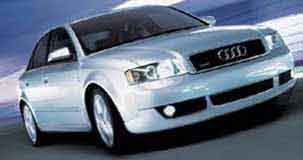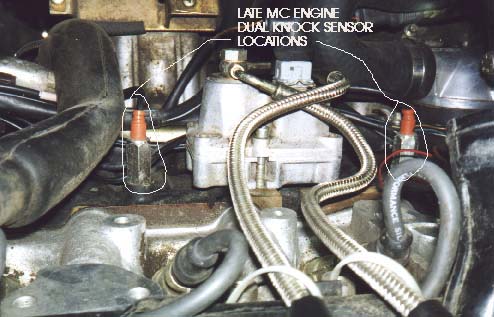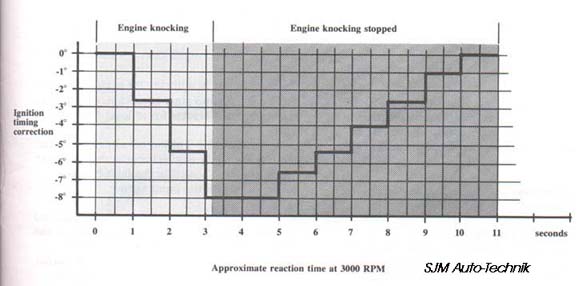

|
ECU System, Technical Tips, 1986-90 5000/200TQ
Check Engine Light On? Hesitation? Low Power? If the "Check Engine" light comes on when the engine is warmed up and the manifold pressure is above 0.7 bar and the engine RPM is above ~3000 RPM, you may have a defective knock sensor, an intermittent connection inside the knock sensor or a connector/wiring problem. Other possibilities include: Poor quality fuel with low octane, Low engine oil levels can cause abnormal engine noises, knocking, lifter clacking, etc. which may confuse the knock sensor. Loose accessory mounting brackets etc, may also fool the knock sensor into thinking the engine is pinging. The mounting surface of the knock sensor must be clean and the mounting torque of the knock sensor is critical for correct operation and should be checked. The MC engines use a knock sensor that should be torqued to 7 lb-ft. You may need to use a crow foot adapter to torque this. The ECU will retard the timing by 7.8 degrees or more if it thinks the knock sensor isn't working. This can make the car stumble or hesitate on acceleration. The newer style replacement knock sensors for the early and late MC engine have gold plated terminals and the wiring harness connector terminal pins should be replaced with these gold plated versions as well. The ECU will turn on this "Check Engine" light whenever there is a problem in the knock sensor system, and the engine is running under appropriate conditions (above 0.7 bar, and 3000 RPM) where engine knock may occur. This "Check Engine" light will also come on if the ECU is sensing continued knocking or pinging and has already retarded the timing the maximum amount (3 steps of 2.6 degrees each) in both the Premium fuel timing map and the Regular fuel timing map. See below for more details. A defective or intermittent Hall sending unit in the distributor will also turn on this "Check Engine" light if a problem occurs while driving the car. A open circuit in the Air Temp sensor may also turn on this light. Moisture inside the ECU can also cause trouble, check the plastic baggy cover over the ECU connector wiring under the right side kick panel where the ECU is located. A defective pressure sensor inside the ECU may also cause the "Check Engine" light to come on and the engine may have excessive pinging. The hose from the intake manifold to the ECU should be checked for leaks as well. Also check the ECU grounds on the intake manifold. Go to the Intake Manifold ground section at the top of this page, for more details. The 1986-88 5000T/Q and early 200TQ (1989 200 Turbo Quattro before VIN # KN038262, 1989 200 Turbo before VIN 44 KN 020000) has the MC engine with a "single" knock sensor with the MAC11 ECU. The later 1989-'90 200TQ dual knock sensor equipped MC engine with the MAC14 ECU, can have the same knock sensor problems as above, here is a photo showing the two knock sensors on the late MC engine.  With a correctly functioning knock sensor system, if pinging is sensed, the ECU will first back off the timing by 2.6 degrees. When the ECU backs off the timing, this can feel like a slight hesitation or surge. The pinging may not be heard by the driver. If pinging still occurs, the timing will again be backed off by 2.6 degrees. More pinging and it backs it off again by 2.6 degrees for a total of 7.8 degrees, if pinging is still occurring, the ECU will change to using the Regular fuel timing map. If pinging is still occurring the ECU will again back off the timing in three steps of 2.6 degrees, at which point it may turn on the "Check Engine" light indicating a poor fuel octane rating or some other problem with an engine component. Here is a chart showing the timing adjustment that occurs if sustained knocking happens for several seconds.  Diagram courtesy of Audi of America, Technical Service Training Booklet The MAC11 ECU does not remember fault codes after you turn off the ignition which may explain why it works ok after re-start. When the car begins running poorly, you may want to leave it running and then check for any fault codes. Check the ECU fault code section for details on checking for any stored codes. The later MC engine uses the MAC14 ECU which has a static RAM that is used to store fault codes even after the ignition is shut off. Some of the 1989-90 200T/Q's have the "Check Engine" light bulb removed from the dash, so if the car is having a problem with one or both of the knock sensors, you may not know it. The "Check Engine" light should come on with the ignition key turned on to the first position. NOTE: The Knock regulation system only operates after the engine coolant temp is above 70 C (158F) and when the manifold pressure is above 0.7 bar absolute and the idle switch is open. This is one reason why you want to take it easy on the engine and keep the boost down until it gets warmed up. You could also have other faults that are causing the poor running, i.e. air temp sensor, coolant temp sensor, throttle switch, RPM or TDC sensor etc. Go to ECU System Technical Tips Copyright © SJM Autotechnik™ , all rights reserved Return to Troubleshooting Tips page. Return to SJM Autotechnik™ main page. |
| About Us Privacy Policy Terms of Use Links Customer Service Safety Information Home |